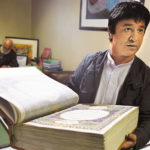
Afghan master miniature artist Abdull Sabur Omari shows a handmade Koran made with silk fabric at the Turquoise Mountain Foundation in Mourad Khani, in the old city section of Kabul.
One of the only Qurans ever made from silk fabric has been completed in Afghanistan — a feat, its creators hope will help preserve the country’s centuries-old tradition of calligraphy.
Kabul: Each of the holy book’s 610 pages was produced by hand in a painstaking process that took a team of 38 calligraphers and artists specialising in miniatures and took nearly two years to finish.
Bound in goat leather and weighing 8.6 kilograms (19 pounds), the Quran was produced by Afghan artisans, many of them trained at British Foundation Turquoise Mountain in Kabul.
“Our intention was to ensure that calligraphy does not die out in this country — writing is part of our culture,” Khwaja Qamaruddin Chishti, a 66-year-old master calligrapher, told AFP in a cramped office inside Turquoise Mountain’s labyrinthine mud-brick and wood-panelled complex.
“When it comes to art we cannot put a price on it. God has entrusted us with this work (the Quran) and this means more to us than the financial aspect,” Chishti continued. Using a bamboo or reed ink pen, Chishti and his fellow calligraphers spent up to two days carefully copying Quranic verses onto a single page — sometimes longer if they made a mistake and had to start again. They used the Naskh script, a calligraphic style developed in early Islam to replace Kufic because it was easier to read and write. The decoration around the script, known as illumination, was more time-consuming, each page taking more than a week to complete.
A team of artists used paint made from natural materials, including ground lapis, gold and bronze, to recreate the delicate patterns popular during the Timurid dynasty in the 15th and 16th centuries in the western city of Herat. “All the colours we have used are from nature,” Mohammad Tamim Sahibzada, a master miniature artist who was responsible for creating the vibrant colours used in the Quran, told AFP. Sahibzada said working on silk fabric for the first time was challenging. The locally sourced material — all 305 metres (1,000 feet) of it, was treated in a solution made from the dried seeds of ispaghula, or psyllium, to stop the ink from spreading.
“We will show it to other Muslim countries to see if it is possible to create job opportunities for graduates to work on another Quran” said Abdul Waheed Khalili, the organisation’s Afghan director. For now it will be kept in a specially made hand-carved walnut wooden box to protect its delicate pages from the elements at Turquoise Mountain’s offices, which are in the restored Murad Khani, a historic commercial and residential area in Kabul’s oldest district.
(Extracted from hindustantimes.com)

COMMENTS